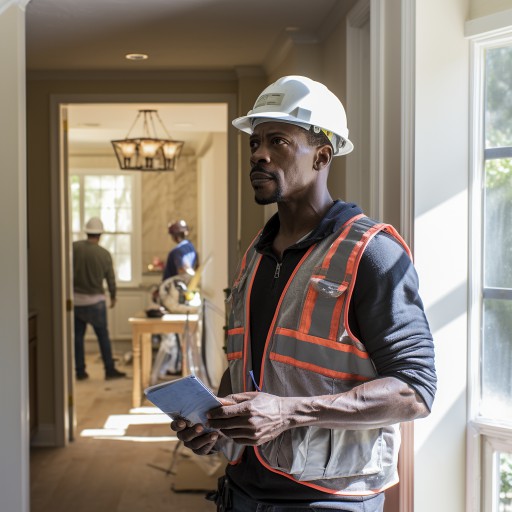Renovation Deposits: A Comprehensive Guide for Homeowners

co-founder
- Renovation Deposits: The Basics
- How Much Should a Renovation Deposit Be?
- The Role of the Payment Schedule
- The Reality of Renovation Costs: Expecting the Unexpected
- Safeguarding Against Renovation Scams
- Final Thoughts
When planning a renovation, many homeowners find themselves navigating a complex labyrinth of financial planning, contractual obligations, and negotiation. One of the most crucial elements of this process is understanding renovation deposits. In this comprehensive guide, we delve into what constitutes a renovation deposit, why it's important, the legal boundaries, and best practices for agreeing on a fair amount.
Renovation Deposits: The Basics
Typically, a renovation project begins with a contract between the homeowner and the contractor. This contract details the scope of work, the total project cost, and the payment schedule. The first payment on this schedule is usually a deposit, also known as a down payment.
The deposit serves several important purposes. For the contractor, it acts as a guarantee that you're serious about the project and willing to commit financially. It also helps cover early costs that the contractor will incur, such as purchasing materials and allocating labor.
However, it's important to remember that the deposit is not an upfront payment for the entire project. The remaining balance is generally divided into 'progress payments', paid at various milestones throughout the project, culminating in a final payment upon completion.
How Much Should a Renovation Deposit Be?
While the specifics can vary greatly depending on the project, a renovation deposit is typically between 10% and 25% of the total estimated project cost. This range serves as a general rule of thumb but can fluctuate based on the scale of the renovation, the materials required, and labor expenses.
Interestingly, laws governing renovation deposits vary from state to state. For example, in states like Maryland, the law caps the deposit amount at around 33% of the total contract price. On the other hand, states like California limit advance payments at the contract signing to 10% of the total estimated job cost or $1,000, whichever is lower.
When planning your renovation, understanding your state's legal framework is paramount. New York provides a handy home improvement fact sheet that says that any deposit needs to go into an escrow account. Bottom line, look up your state and any laws that pertain to home improvements. They can help a lot. If your state doesn't have specific laws pertaining to renovation deposits, the key lies in negotiating an amount that's fair and comfortable for both parties.
The Role of the Payment Schedule
Beyond the deposit, the payment schedule is a pivotal component of the renovation process. This schedule, usually included in the initial contract, outlines when and how much you'll pay the contractor throughout the project.
A well-crafted payment schedule is typically tied to project milestones. For instance, you might make a payment after the completion of the demolition phase, another after the installation of cabinets and countertops, and so on. This structure ensures that payment aligns with progress, providing financial protection for both you and the contractor. The final payment is generally due upon completion of the project, once you're satisfied with the work done.
Why is a Payment Schedule Important?
A clear and concise payment schedule is beneficial for both the homeowner and the contractor. For the homeowner, it helps in budgeting for the project, as you'll know when payments are due and how much they'll be.
For the contractor, a payment schedule ensures a steady cash flow to cover labor costs, materials, and other expenses during the project. It also provides a sense of security and trust, as both parties know when funds will be transferred.
What Does a Good Payment Schedule Look Like?
While there is no one-size-fits-all payment schedule, a good one should clearly define when payments are due and what each payment covers. Often, payment schedules are based on the completion of specific milestones or stages. Here are some common elements of a good payment schedule:
Deposit: As discussed earlier, this is an upfront payment that typically ranges from 10% to 33% of the total contract price. This money often goes towards securing your spot on the contractor's schedule and purchasing initial materials.
Progress Payments: These are installments paid as specific stages of the project are completed. For example, you might make a payment after the demolition is finished, another after plumbing and electrical work is done, and so forth. These payments are usually percentage-based and should align with the completion of significant work stages.
Final Payment: This is the last payment you make, often ranging from 10% to 20% of the total cost. It's typically paid once you're satisfied with the finished project and have verified that all work is complete and up to standard.
How to Negotiate a Payment Schedule
Negotiating a payment schedule begins with understanding your financial situation and your contractor's needs. Keep these key points in mind:
Transparency: Be upfront about your budget and cash flow. A contractor who knows your situation can better align the payment schedule with your capabilities.
Ask for Detailed Breakdowns: Make sure your contractor provides a detailed breakdown of the project's stages and the costs associated with each. This can help you understand why certain payments are required at specific times.
Timing is Everything: Align payments with significant project milestones. Avoid schedules that require large payments before substantial work has been done.
Hold Backs: In some regions, it's common to hold back a portion of the payment (often 10%) until 30-45 days after the project's completion. This is known as a "lien holdback" and can protect you if subcontractors or suppliers claim they haven't been paid.
Dispute Resolution: Plan for the unexpected. Include a process in your contract for resolving any disputes about payments or the work's satisfactory completion.
Remember, communication is vital throughout this process. An open, honest conversation about expectations can go a long way in ensuring a smooth and successful renovation project.
The Reality of Renovation Costs: Expecting the Unexpected
Even with a clear deposit and payment schedule, it's essential to remember that renovation costs can sometimes (and likely will) go beyond initial estimates. Unforeseen issues, such as structural problems uncovered during demolition or changes you decide to make mid-project, can lead to cost overruns. To safeguard against such scenarios, many experts recommend having a contingency budget of 10-20% of the total estimated cost.
Additionally, any changes to the original contract should be documented in writing via change orders. These documents describe the change, how much it will cost, and its impact on the schedule. Change orders help maintain transparency and ensure that both parties are in agreement about the changes and their effects.
Safeguarding Against Renovation Scams
Unfortunately, the home renovation industry isn't immune to scams. Some unscrupulous individuals may pose as contractors, demanding large deposits, and then disappearing. To protect yourself, do your homework. Verify your contractor's license, check their references, and ensure they have proper insurance.
Another protective measure is to avoid paying the full cost upfront. A reputable contractor won't expect the total payment before work has begun. If a contractor demands full payment in advance, consider it a red flag.
Final Thoughts
A renovation deposit marks the beginning of your renovation journey. It's a commitment, a reassurance, and a stepping stone towards the home you envision. By understanding the legal framework in your state, having a clear payment schedule, and preparing for unexpected costs, you can navigate the financial aspects of the renovation process with confidence.
Whether you're giving your kitchen a facelift, adding a room, or revamping your entire home, every renovation is an investment. By understanding the intricacies of renovation deposits, you can ensure you're investing wisely.
Stay tuned for our next section where we will delve into negotiation strategies for agreeing on a fair deposit, the pros and cons of different payment methods, and how to protect yourself against renovation scams.

Renovate with EcoHome
EcoHome empowers homeowners to confidently build healthy and comfortable homes for a fair price.
Sign UpLocations View All →
NY
- Albany
- Binghamton
- Buffalo
- Esopus
- Freeport
- Hempstead
- Highland
- Kingston
- Long Beach
- Marlboro
- Mount Vernon
- New Paltz
- New Rochelle
- New York City
- Niagara Falls
- North Tonawanda
- Olivebridge
- Plattekill
- Rochester
- Rome
- Saugerties
- Schenectady
- Shandaken
- Syracuse
- Troy
- Utica
- Valley Stream
- Wallkill
- Woodstock
- Yonkers
NJ
- Bayonne
- Brick
- Camden
- Cherry Hill
- Clifton
- East Orange
- Edison
- Elizabeth
- Jersey City
- Lakewood
- Middletown
- Newark
- Old Bridge
- Passaic
- Paterson
- Toms River
- Trenton
- Union City
- Woodbridge
CT
PA
- Allentown
- Altoona
- Bethel Park
- Bethlehem
- Chester
- Easton
- Harrisburg
- Hazleton
- Lancaster
- Lebanon
- Monroeville
- Philadelphia
- Pittsburgh
- Reading
- Scranton
- Wayne
- Wilkes Barre
MD
- Abingdon
- Baltimore
- Bethesda
- Bowie
- Columbia
- Dundalk
- Ellicott City
- Frederick
- Gaithersburg
- Germantown
- Glen Burnie
- Potomac
- Rockville
- Severn
- Silver Spring
- Towson
- Waldorf



